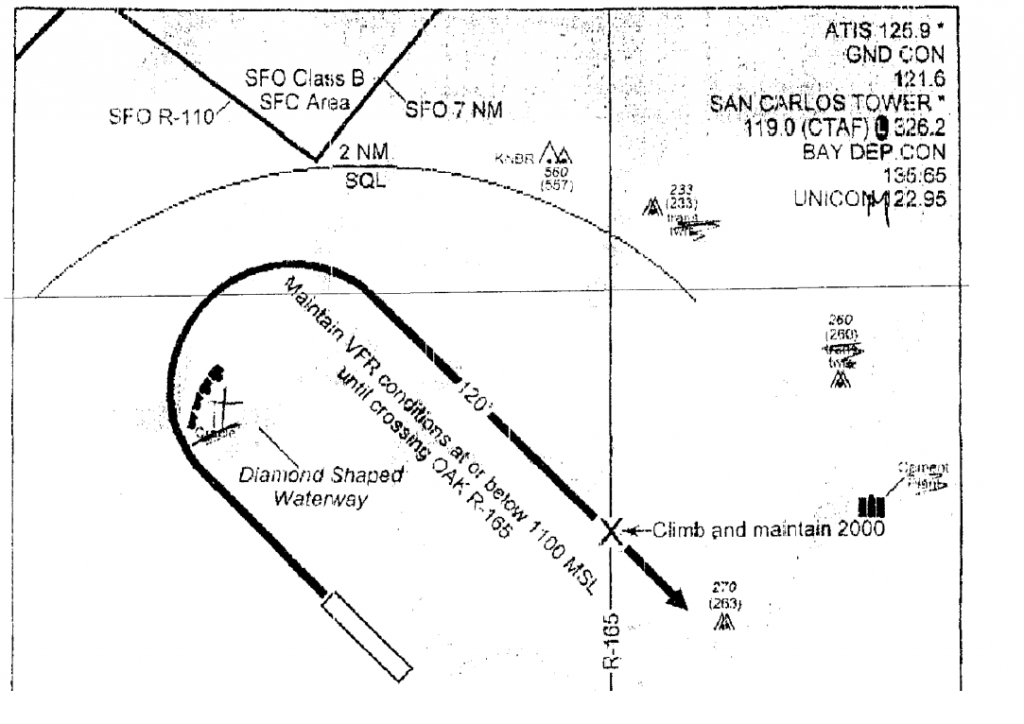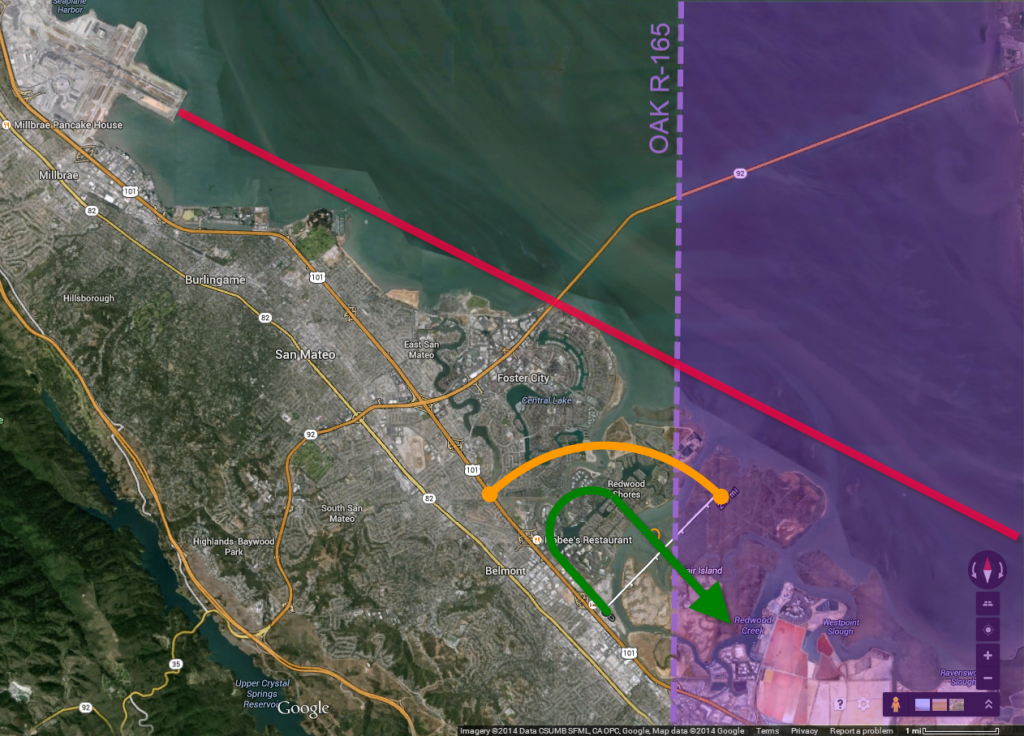Sometimes you’ll get an IFR clearance that will be a complete head-scratcher. It’s almost as if ATC deliberately tries to come up with the most incomprehensible language possible. The very first clearance I ever received was just like that. Departing San Carlos (KSQL), I was instructed:
Fly runway heading to the diamond shaped waterway, turn right heading 120 within two miles of the airport, radar vectors Woodside, Victor 25, Salinas, direct, maintain VFR at or below 1,100 until crossing the Oakland 165 Radial, then climb and maintain 2,000, expect 5,000 after five, blah blah blah.
WTF? It turns out this departure is notorious; many blog postings and articles have been written about it. The local pilot association once charted it as a joke instrument plate, which sprung up on FBO bulletin boards all around the airport. I received a call a few weeks ago from a fellow pilot who received this clearance while departing San Carlos in a Lancair Evolution. After a few rounds with Ground, he finally got the readback correct. But still not fully understanding the departure, he asked, “Can you give that to me in English?” Ground replied, “It’s basically a right down wind departure. Just turn to 120.” That’s a pretty good description of the procedure, but it left out some key elements, like the emphasis on staying within 2nm of the airport.
I received a call a few weeks ago from a fellow pilot who received this clearance while departing San Carlos in a Lancair Evolution. After a few rounds with Ground, he finally got the readback correct. But still not fully understanding the departure, he asked, “Can you give that to me in English?” Ground replied, “It’s basically a right down wind departure. Just turn to 120.” That’s a pretty good description of the procedure, but it left out some key elements, like the emphasis on staying within 2nm of the airport.
For those of you not familiar with the Lancair Evolution, it is a rip-snorting, four-place, pressurized, turboprop, crotch-rocket of an airplane that can easily climb at 4,000 fpm. The passenger that day was not a comfortable flyer. Turbulence on departure caused the airplane to roll into a 30-40 degree bank, which caused the passenger some distress, so our pilot shallowed into a gentle turn to downwind. Well, a gentle turn at the speed of an Evolution is a very wide turn indeed. After being handed off to Norcal Departure, our pilot was given a phone number to call. It turns out, his wide turn had forced a 747 on approach to SFO to break off and re-sequence.
Hindsight Is Not Always 20-20
That pilot and I had a long email exchange about this event. Since I knew the procedure in detail, I fell into the trap of trying to explain why the clearance is the way it is: Runway 30 is not authorized for IFR departures, so an IFR clearance must start with a VFR noise abatement procedure; aircraft departing San Carlos must stay within 2 nm of the airport to remain clear of the SFO approach corridor; the switch from VFR to IFR can’t happen until you reach the MVA sector bounded by the OAK 165R, etc.  The pilot’s response was:
The pilot’s response was:
If you are VMC they should just tell you “Runway heading for 1 mile then depart close-in right downwind. Call departure.” Even the TRACON people thought it was a crazy clearance. There are at least three waterways put there and I have the nose up in a moderately turbulent climb and I’m trying to ID which one is “diamond shaped”…
In other words, why can’t they just give it to me in English. Well, they did, and look how it turned out. Each statement in that clearance is there for a reason, and if you leave out those details, a loss of separation can occur. If you are confused about your departure instructions, there is nothing wrong asking for clarification. I suspect there are other crazy departure procedures out there with similar issues. Leave a reply if you know of any. If you find yourself in this pilot’s circumstance, where you don’t fully understand the procedure, don’t be afraid to ask, “Can you give that to me in English?” BUT, after you get the English version, make sure to go back to the clearance as originally prescribed and confirm you understand all the nuances. The devil is in the details. If you remain confused, ask further questions. For example, a good question in this case might have been, “What am I supposed to stay within 2nm of?” As my airline pilot friends like to say, “Don’t be in a rush to screw it up.”


The Dalton Departure Runway 19 at Teterboro is another instance of a combination VFR/IFR procedure with a high level of pilot deviations. This has, in part, been resolved by ATC by requiring pilots to have a textual description of the procedure in order to perform it. ATC can’t just issue the clearance to anyone. This might be worth doing at SQL.